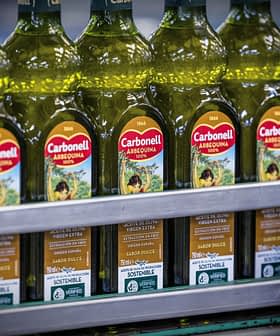Spain Sees Largest Olive Oil Consumption Increase in Nearly a Decade
Olive oil consumption in Spain rose by more than three percent, the biggest increase since 2011. Falling prices and better education about extra virgin olive oil's health benefits are attributed to the increase.
A new report from Spain’s Ministry of Agriculture, Food and Fisheries showed that household consumption of olive oil increased by 3.47 percent in 2018, the largest increase since 2011.
Consumption of virgin and extra virgin olive oil led the way, rising by 9.2 and 7.2 percent, respectively. Consumption of non-virgin olive oil rose slightly, by only 0.2 percent.
Unión de Uniones attributes these changes to the decline in prices… as well as to a greater knowledge and information on the part of consumers of the benefits of extra virgin olive oil, which have yet to be strengthened.
Combined, the Ministry estimates that olive oil represented 64.9 percent – nearly two-thirds – of all vegetable oil consumed in Spain last year.
One of the reasons that olive oil consumption is bucking the previous downward trend may be the dramatic decrease in prices that Spain has experienced this year.
See Also:Olive Oil Consumption NewsAt this time in 2017, olive oil was retailing at an average of €3.77 ($4.25) per kilogram, according to Poolred, an organization that tracks olive oil prices. Since then, prices have fallen by more than 40 percent, reaching €2.14 ($2.42) per kilogram, on average, at the time of writing.
Spain’s Union of Farmers’ and Ranchers’ Unions attributed the increase in consumption not only to the lower prices, but also better education about the health benefits of olive oil.
“Unión de Uniones attributes these changes to the decline in prices… as well as to a greater knowledge and information on the part of consumers of the benefits of extra virgin olive oil, which have yet to be strengthened,” the organization said in a statement on its website.
In spite of dropping prices, the value of olive oil purchased by Spaniards slightly increased, rising by 1.4 percent. Perhaps reflecting the lower prices, the value of virgin olive oil purchased increased the most, rising by 3.8 percent, while value of extra virgin olive oil purchased rose by 2.5 percent. The value of non-virgin olive oil purchases, however, fell by 6.5 percent.
The report also pointed out that the vast majority of people consuming olive oil, and other types of vegetable oils, are older and that olive oil consumption among Spain’s young people remains quite low.
According to data from the Ministry, Spaniards aged 50 and older accounted for 71.7 percent of non-virgin olive oil consumed in Spain in 2018, 66.5 percent of virgin olive oil and 69.4 percent of extra virgin olive oil.
Meanwhile, Spaniards under the age of 35 accounted for 5.6 percent of non-virgin olive oil consumption, 6.6 percent of 5.6 percent of extra virgin olive oil consumption.
The report offered no analysis as to why olive oil consumption among young people remains so low, but did state that couples with older children, couples without children and retired adults in the middle class were most likely to purchase all three types of olive oil.








